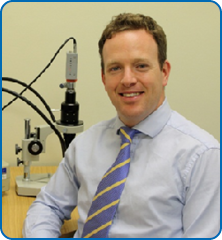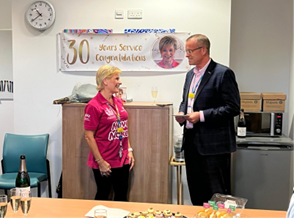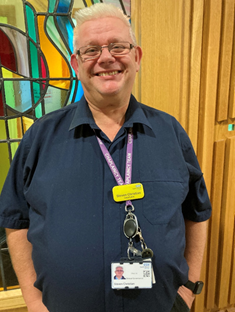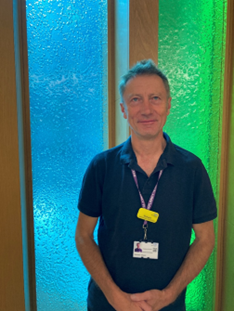Regular
Off
Off
Welcome
Kerry Than, Head of Patient Experience
Hello, we hope you enjoyed the summer sun and are looking forward to the cosy months ahead. It’s been an exciting few months in Patient Experience which we hope you enjoy reading all about!
I will be returning to Derby this month as Head of Patient Experience there whilst Emily rejoins you here. It’s been a joy to work at NBT and meet so many passionate people. I want to wish you all the very best as you take the next steps in the proposed merger. I truly believe that the benefits for patients, carers and everyone who uses our services will be invaluable. Together, we have a real opportunity to make care even better.
Community Participation Group
Earlier this month, we were delighted to bring people together for the very first meeting of the Bristol NHS Group’s Community Participation Group held at the Watershed in central Bristol.
This new group brings together people with lived experience of our services, local community networks, and voluntary organisations. United by a shared commitment to improving health and care, this group will help shape the future in line with our Joint Clinical Strategy.
Our first session was all about making connections, building trust, and starting to shape how we’ll work together. We also took time to explore the ambitions behind our Joint Clinical Strategy. It was a really positive and collaborative beginning to what we hope will be a long and meaningful journey.
We’re looking forward to sharing more as the group grows and continues to help shape a more inclusive, community-led approach to healthcare and service development.
Volunteer Services
Bwalya Treasure, Volunteer Operational Lead
We are excited and busy organising our Volunteer Thank You event taking place on the 1st November at BAWA. This event is our way of showing appreciation to our incredible volunteers. It’s a chance for them to come together with staff, share in the celebration, and feel truly valued. We’ll also be honouring those who’ve reached long service milestones with special awards - thank you for all that you do!
We were delighted to mark a special milestone for our Move Maker Volunteer Manager Jill, who recently celebrated 30 years of NHS service. Jill's leadership, dedication and passion for supporting Move Makers has a lasting impact on the experience of patients, visitors and staff. Thank you Jill, for three decades of outstanding service and commitment to making a difference.
Fresh Arts
Art on wards
Donna Baber, Fresh Arts Manager
This summer Fresh Arts worked with teams in antenatal, Cotswold ward and gynaecology cancer services to choose artwork to go into spaces in which difficult news is relayed to patients. A selection of tree and nature based photographic images provide a calming perspective beyond the space of these rooms which are sometimes windowless. We worked with the team on Gate 34B to choose artwork by Cath Read for their Relatives Room and ICU who chose uplifting artwork of local scenes by Jenny Urquhart to revamp their windowless Relatives Rooms.
Thanks to a generous donation to Southmead Hospital Charity by the family of a patient who sadly passed away on Gate 33B we worked with patients and staff to improve two patient bedrooms at end of the ward which are tucked into the corner of the building with a small, dark outlook. Inspired by a regular patient to Gate 33B, unable to leave her room she misses the outdoor spaces that nurture her wellbeing; patients and staff chose imagery of forests that were installed as floor to ceiling wall vinyls.
New artwork designed by Lynda Porter was installed on ceiling tiles and walls in 6 Resus Bays in ED. In addition, the Relatives Room and Rose Cottage have been completely revamped with a soft green wall paint and a collection of photographic prints and light boxes by Lynda Porter now enhance these spaces. Lynda was grieving the passing of her father when she created these works so these are a sensitive response to difficult times.
On 27 September, the Fresh Arts team and several members of the Patient Experience team took part in the 25km hike from Bristol to Bath with the aim of raising £10k for the Fresh Arts Programme. Please consider sponsoring us by donating here: https://southmeadhospitalcharity.enthuse.com/pf/team-fresh-arts
Patient Feedback & Engagement
Troy Crompton, Patient Experience Manager
We recently filmed a patient story in the Macmillan Wellbeing Centre. We heard from several patients who shared how important, powerful and healing the craft sessions that volunteer Liz runs at the centre can be. Her paper flowers have also been used for a hospital wedding!
Spiritual, Pastoral and Religious Care (SPaRC)
Chaplaincy Volunteers Training Course
Steve Christian, Chaplaincy Team
The Chaplaincy team recently welcomed two familiar faces into new roles.
Firstly, Steve Christian has been appointed as Interim Lead Chaplain. Steve joined the team as a Chaplain 12 months ago and has now stepped into the lead role following Mark Read's retirement. We wish Steve the very best as he leads the team through their journey and helps to shape the service as part of the Hospital Group.
We also welcome Richard, who joined the chaplaincy team as a volunteer ward visitor in 2023 and has now become an honorary Chaplain. His new role will see him supporting patients and families at end of life, through maternity loss and supporting patients and families who experience trauma.
The Chaplaincy Team are based in the Sanctuary Area at Gate 30. They are available not just for patients and visitors but also for staff. They seek to help people of faith and none. If you're looking for a compassionate ear or assistance with religious or spiritual matters, please feel free to visit or reach out to the team on extension 43700. They're here to support you.
PX June banner image.png
Patient Experience Newsletter October 2025





